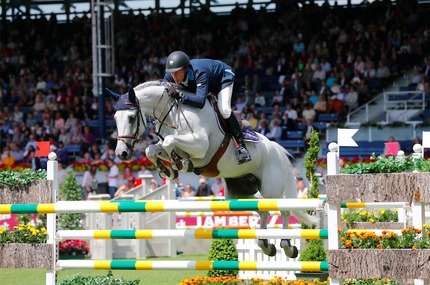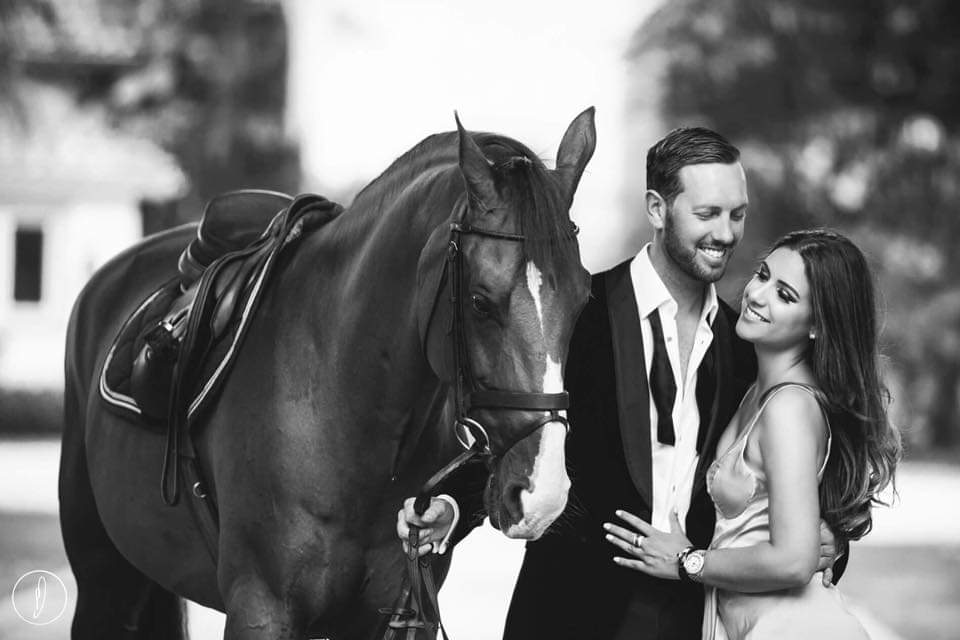
Recognizing potential in the young showjumping prospect
Blog
Recognizing potential in the young showjumping prospect
How do you spot talent in an up-and-coming show jumper? We sat down with professional show jumping rider, trainer and instructor Daniel Zetterman to find out.
Daniel Zetterman is best known for his partnership with the horse Glory Days, with whom he competed in the Nations Cup. Daniel grew up in Sweden, where his family raised horses and his father and brother are top showjumping riders. Daniel worked his way up the ranks to compete successfully at the Grand Prix 5 star level in both Europe and the US. In 2012 he was the Swedish National Champion. Currently he is based in Wellington, Florida.

Daniel and Hermès SV victory lap in 7 year old class at Falsterbo Horse Show | Photo credit Hippson
What I look for in a horse will depend a lot on what the plan is for his future. I am going to buy a different horse for myself, than for resale, or for an amateur client. However, in my experience, good show jumpers have a lot of common qualities. The biggest difference is how much Thoroughbred blood, which brings sensitivity and quickness, the rider can manage.
I usually don’t recommend a prospect for an amateur, unless they are already an experienced rider. If I am looking for an amateur client, I want a horse that gives his rider confidence, and that can tolerate mistakes, so the rider builds good experiences.
When I am looking for a project, or a horse for myself, I like to look at young prospects when they are coming 5 years old. At this age they are going well enough under saddle for me to assess, but they are not so old that they have been shaped too much by another trainer’s methods. By the age of 6 or 7, I need to consider whether the horse will transition well to my training system.
I think the most important quality in a horse is a good mind. The best horses are always listening to their riders in an open-minded way. These horses are smart and pick things up quickly. An ambitious horse can improve that much quicker, but you have to be careful with a horse that has a mind of his own. These types are more of a gamble, and take a different approach to develop.
For myself, I like a medium blooded temperament; this usually means the horse has some blood in him [Thoroughbred bloodlines]. The blood makes the horse have fast reflexes and an easy canter. If you have too much blood, the horses can be too hot and difficult to maneuver. They are not always able to control themselves and can get in to trouble approaching parts of the course in a fast unbalanced way. The medium horse is normally quick, flexible and athletic enough to do its job, even though he/she might be a little less fast with the reflexes but it will have time to handle the given situation with good focus.
I don’t look at flashiness but a nice technique. Of course we want a horse with scope, but I want to know if the horse is smart enough to use his body without tiring himself out. I like to see an efficient horse. A big jump is impressive, but a top horse knows how to conserve his body by maintaining even power and sharpness throughout the course.
I do consider the bloodlines very much. When you are knowledgeable about the lines, you appreciate what is typical of certain sires and what issues to expect. Of course we look to see if the stallion has successful offspring, but the mother and her bloodlines are normally the most important. The strongest genes come through the mother and her family lines. Ideally I would like to see dams who were riding horses before becoming broodmares.

Daniel and Glory Days in Aachen | Photo credit Tomas Holcbecher
My best horse, Glory Days, was out of an Irish mare my mother bought. That mare had a lot of blood. She was very careful, but she was also bordering on crazy. She was a successful show jumper for my father until she was injured at age 10. We bred her to the stallion Cardento, who was doing well with Peter Eriksson. He had a good, balanced temperament, and a nice way of jumping with a lot of scope. Their offspring, Glory Days, inherited the good power and temperament from his sire, plus he got the quickness from his mother.
When I go to look at a horse, I like to watch the horse being ridden first. Does the horse seem cooperative? Does he seem agile and able to navigate the fences effortlessly? Of course a good rider can make a horse look easy. I do look to see what the rider’s strengths and weaknesses are. If my strengths are different in a way that would benefit the horse, the horse could be a good training prospect for me.
When I try the horse, I start off with the basics. I want to know how sensitive is the horse to my aids. Do they go forward from the leg in a nice way? I test ride some transitions. Does the horse improve after I ride transitions? Does the horse hold his balance well? Over fences, I will try some tricky lines to see how the horse gets himself out of trouble by being sharp minded. I want to see how they cope with certain situations and how effortlessly he/she can recover to be ready for the next jump.
You never know where you might find a great horse. In Sweden, local horse dealers were always calling my father about an “amazing four-year-old” in their barn. A friend with a sale barn just down the road from our house finally convinced my father to come look at just such a horse. My father did buy the horse, and by 8-9 years old that horse was at the top of the sport. The horse’s name was Isaac, and with him my father won many Grand Prix, World Cup qualifier and jumped the WEG in Aachen.
At the end of the day, I think it is important to choose the horse that can benefit from your riding. You need to consider that a horse can get better or worse when it changes riders. When you get along really well with a horse, it is possible to bring out its best in a beautiful and artistic way. Of course, it’s also good to find horses that bring out the best in their riders.

Daniel and his wife Alyssa | Photo credit Philippa Davin
Daniel Zetterman has many achievements as a rider with placings in 5* GP's, jumping clear rounds for Sweden in 5* nations cups at great competitions such as Dublin, Hickstead, Rome, Barcelona and Aachen. He has earned 5 Swedish -and 3 Nordic Champion gold medals.
Daniel has been competing at WEF since 2012. He moved from Sweden to Wellington, FL three years ago. He is discovering a new passion, and that is for teaching other riders. He explains, “Improving a horse and rider and achieving success gives me the same thrill as riding a clear round at Grand Prix.”
